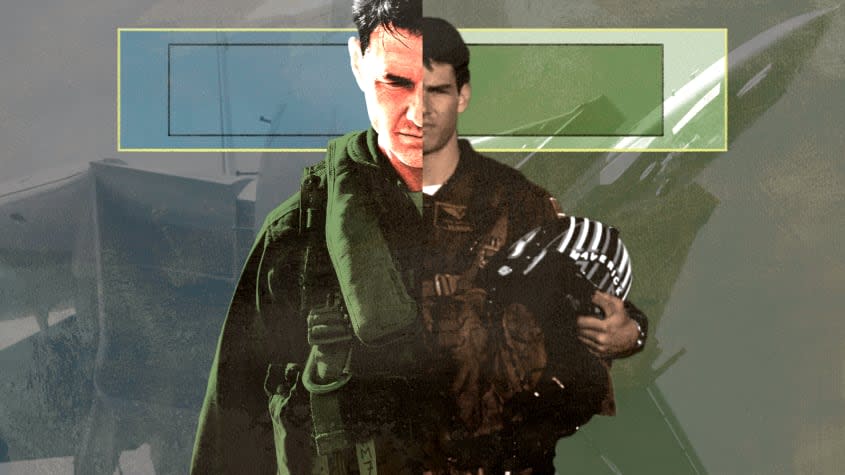What makes a good legacy sequel?

- Oops!Something went wrong.Please try again later.
- Oops!Something went wrong.Please try again later.
The box office success of Top Gun: Maverick has movie lovers looking back on other legacy sequels, whether they were beloved or bombed. Here's everything you need to know:
What is a legacy sequel?
A "legacy sequel" is a new entry in a long-dormant film franchise. According to IGN, characteristics of a legacy sequel can include "narrative and thematic preoccupation with the concept of legacy," a desire to deliver "nostalgic moments and fan service," the pairing of aging actors with fresh new faces, and an attempt to draw multigenerational audiences.
An early example of a legacy sequel is Martin Scorsese's The Color of Money (1986), which starred young hotshot Tom Cruise alongside Paul Newman, who reprised his role as pool shark Fast Eddie Felson from 1961's The Hustler. The same year The Color of Money was released, Cruise also starred in the naval aviation thriller Top Gun. Cruise's career has since come full circle. In the critically and commercially successful Top Gun: Maverick (2022), Cruise is the old-timer showing young hotshot Miles Teller the ropes.
Other legacy sequels — like TRON: Legacy (2010) — trickled in over the years, but in 2015 the dam broke. Star Wars: The Force Awakens and Jurassic World raked in $1.5 billion between them, while Creed and Mad Max: Fury Road each grossed nine figures. The deluge hasn't let up since.
Follow-ups to comedies like Dumb and Dumber and Zoolander, blockbuster action capers like Men in Black and Bad Boys, sci-fi franchises like The Matrix, and even art-house fare like Trainspotting have been lavished (and, in some cases, inflicted) upon audiences in great numbers.
What do legacy sequels say about American culture?
In his book The Decadent Society, Ross Douthat mentions the dominance of legacy sequels as an indicator of the "cultural and intellectual exhaustion" of contemporary America. "A society that generates a lot of bad movies need not be decadent; a society that just makes the same movies over and over again might be," Douthat writes.
As an example, Douthat cites Back to the Future (1985), in which the time-traveling Marty McFly terrorizes his father by impersonating Darth Vader — in 1955. A Zoomer couldn't play the same trick on his Gen X dad. They both grew up with Star Wars.
Writing for Movieweb, Richard Fink agrees that "there is an inherent cynicism in the concept of bringing a long-running franchise back with fan-favorite actors years later" as "an easy and cheap nostalgic gimmick." But, Fink argues, many legacy sequels "have embraced the concept to tell interesting, thoughtful stories" that "have moved the franchises forward" and "grapple[d] with the idea of nostalgia."
This line between regurgitation and re-examination can be difficult to walk. Some Star Wars fans criticized J.J. Abrams for the play-it-safe fan service he offered in The Force Awakens. Others accused Rian Johnson of treason for his more subversive approach to The Last Jedi. Either way, studios have little incentive to stop making legacy sequels. The two films — along with Star Wars spinoff Rogue One — topped the U.S. box office three years running.
What makes a legacy sequel work?
Of course, not all legacy sequels are guaranteed moneymakers. 2019's Terminator: Dark Fate was one of the biggest box-office bombs of all time, losing studios north of $100 million. Some viewers bristled at its preachy revisionism while others simply couldn't be bothered to turn out for what was, by one count, the fourth attempt to reboot James Cameron's franchise.
Legacy sequels "need to understand what made" the original film(s) "popular in the first place," writes Brandon Katz for Observer, while finding the "balance between old and new." A good legacy sequel, he argues, must "honor the past, but also chart its own path forward."
Even a good legacy sequel is not necessarily a profitable one. Blade Runner 2049 (2017) and The Shining sequel Doctor Sleep (2019), both follow-ups to 80s cult classics, failed to break even despite positive reviews. Audiences leaped at the chance for more Jedi and dinosaurs. Another stay at the Overlook? Not so much.
Sometimes, though, a legacy sequel succeeds on all fronts, charming critics, fans, and audiences alike. Top Gun: Maverick is one such unicorn. On Rotten Tomatoes, the film has a 99 percent audience score and positive reviews from 96 percent of critics. Mark Kennedy of The Associated Press said Tom Cruise's return to the cockpit is a "textbook example of how to make a sequel." Time's Stephanie Zacharek called it a "much better film" than the original.
So maybe decadence isn't all bad.
You may also like
What the CDC's new study tells us about long COVID
European Union leaders agree to ban most imports of Russian oil

